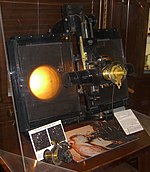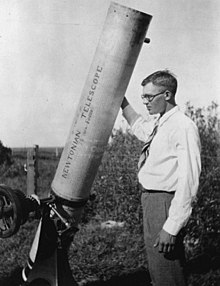Clyde Tombaugh
Clyde William Tombaugh (born February 4, 1906 in Streator , Illinois , † January 17, 1997 in Las Cruces , New Mexico ) was an American astronomer . In 1930 he discovered the dwarf planet Pluto , which was the ninth planet in the solar system until 2006 .
Life
Tombaugh was born to a family of farmers. His hopes of attending Streator College were dashed when a hailstorm devastated his parents' property. The family moved to Kansas in 1922 and started a new life near the town of Burdett. Young Clyde studied on his own, teaching himself geometry and trigonometry . At the age of 20, he built his first telescope . He watched the Mars and Jupiter , and sent drawings of his observations at the Lowell Observatory in Flagstaff ( Arizona ). He was really only asking for help and suggestions, but Vesto M. Slipher , the director of Lowell, offered him a position as research assistant ( junior astronomer ) in 1929 . Tombaugh accepted and stayed there for 14 years.

Here he was commissioned to carry out a systematic search for a trans-Neptunian planet (also called Planet X), which had been predicted by Percival Lowell on the basis of the calculations of the mathematician Elizabeth Williams and William Pickering . On February 18, 1930, he made the discovery of his life by recognizing a moving object as the long-sought trans-Neptunian object . It was the third systematic search operation, financed by Percival Lowell in 1916. The unknown celestial body was later named after the Roman god of the underworld Pluto , who was able to make himself invisible (Lowell's initials PL are also said to have been decisive). In the years that followed, Tombaugh discovered hundreds of new asteroids and two new comets .
On February 18, 1980, the asteroid (1604) Tombaugh was named after him. Tombaugh did not live to see the revocation of Pluto's planetary status in 2006.

Tombaugh graduated from Burdett High School in 1925 and was finally able to take up astronomy at the University of Kansas on a scholarship in 1932 . In 1936 he obtained a bachelor's degree and in 1938 a master's degree . From 1943 he was a lecturer in physics at Arizona State Teachers College, now Northern Arizona University , and was later instructor for navigation tasks. In 1945 he worked as a visiting professor of astronomy at the University of California, Los Angeles .
For lack of money, he was unable to resume his old position at the Lowell Observatory after the Second World War . Instead, he developed optical orbit tracking telescopes for the A4 rockets that were tested there at the White Sands Proving Grounds from 1946. In 1955 he moved to the New Mexico State University in Las Cruces , where he established the Astronomy Department and until his retirement in 1955 1973 taught astronomy. During this time he met a young man in the neighborhood: Jaron Lanier . Lanier learned to grind lenses from Tombaugh, which later benefited him when developing the first VR glasses.
On January 19, 2006, the New Horizons space probe launched to explore the dwarf planet Pluto. Also on board are ashes from Clyde Tombaugh.
Tombaugh was married to Patricia (Patsy) Edson (1912–2012) from 1934. The marriage resulted in two children; the asteroid of the inner main belt (2941) Alden is named after his son Alden . Since 1974 he has given its name to the Tombaugh cliffs on Alexander I Island in Antarctica.
literature
- David H. Levy : Clyde Tombaugh - discoverer of planet Pluto. Sky Publ. Corp., Cambridge 2006, ISBN 1-931559-33-3 .
Web links
- Publications by CW Tombaugh in the Astrophysics Data System
- Obituaries for CW Tombaugh in the Astrophysics Data System
- Clyde W. Tombaugh, 90, Discoverer of Pluto Obituary, The New York Times, January 20, 1997 (accessed August 26, 2010)
- Clyde W. Tombaugh Collection New Mexico State University Library
Individual evidence
- ↑ Minor Planet Circ. 5280
- ↑ Jaron Lanier : Dawn of the new everything: encounters with reality and virtual reality . First ed. Henry Holt and Company, New York 2017, ISBN 978-1-62779-409-1 .
- ^ Lutz D. Schmadel : Dictionary of Minor Planet Names . Fifth Revised and Enlarged Edition. Ed .: Lutz D. Schmadel. 5th edition. Springer Verlag , Berlin , Heidelberg 2003, ISBN 978-3-540-29925-7 , pp. 186 (English, 992 pp., Link.springer.com [ONLINE; accessed on September 23, 2019] Original title: Dictionary of Minor Planet Names . First edition: Springer Verlag, Berlin, Heidelberg 1992): “1930 YV. Discovered 1930 Dec. 24 by CW Tombaugh at Flagstaff. "
| personal data | |
|---|---|
| SURNAME | Tombaugh, Clyde |
| ALTERNATIVE NAMES | Tombaugh, Clyde William (full name) |
| BRIEF DESCRIPTION | American astronomer and discoverer of the dwarf planet Pluto |
| DATE OF BIRTH | February 4, 1906 |
| PLACE OF BIRTH | Streator , Illinois |
| DATE OF DEATH | January 17, 1997 |
| Place of death | Las Cruces , New Mexico |
